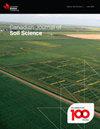Influence of tea-Pleurotus ostreatus intercropping on soil fungal diversity and community structure
IF 1.5
4区 农林科学
Q4 SOIL SCIENCE
引用次数: 2
Abstract
Abstract: Understanding the relationship between soil fungal communities and soil function is vital to establish a sustainable and ecologically friendly tea (Camellia sinensis L.) cultivation. However, there is limited research on the response of soil fungal communities to tea-fungus intercropping, particularly how it is related to soil biodiversity and fertility. Here, we assessed and compared the fungal communities using a metabarcoding technique, soil properties in three plantations (1, 2, and 5 yr of tea-Pleurotus intercropping plantations), and a 5 yr chemically fertilized monoculture plantation. We obtained a total of 3493 operational taxonomic units (OTUs) from four tea plantations. Five hundred and ninety-three fungal OTUs are shared by all plantations, and the other 471 fungal OTUs are shared by three plantations. The largest number of OTUs was recorded in 5 yr tea-Pleurotus intercropped plantations (N = 2040), followed by 2 yr (N = 2024) and then 1 yr (N = 1471), while the chemically fertilized plantation recorded 1823 OTUs. Tea-Pleurotus intercropping showed a significant effect on the increased diversity of soil fungal diversity compared with the monoculture tea cultivations. Fungal groups Basidiomycota, Ascomycota, and Mortierellomycota were the most abundant taxonomic groups recorded in all soil samples. Principal coordinate analysis revealed that fungal community composition in tea-Pleurotus intercropped plantations and monoculture tea plantations was significantly different. Besides, redundancy analysis revealed that soil nutrients significantly influence soil fungal community composition. Our results demonstrate that tea-Pleurotus intercropping may offer long-term benefits to soil biodiversity and sustainable benefits in the tea plantations.茶菇间作对土壤真菌多样性和群落结构的影响
摘要/ Abstract摘要:了解土壤真菌群落与土壤功能之间的关系,对于建立可持续的生态友好型茶(Camellia sinensis L.)种植至关重要。然而,土壤真菌群落对茶菌间作的响应,特别是与土壤生物多样性和肥力的关系研究有限。在这里,我们使用元条形码技术评估和比较了3个人工林(1、2和5年的茶侧柏间作人工林)和5年化学施肥的单一栽培人工林的真菌群落和土壤特性。从4个茶园共获得3493个操作分类单位(otu)。所有种植园共有593个真菌otu,其余471个真菌otu由三个种植园共享。5年间作茶林的OTUs数量最多(N = 2040), 2年次之(N = 2024), 1年次之(N = 1471),而施用化学药剂的OTUs数量为1823。与单作茶园相比,茶-杏间作对土壤真菌多样性的增加效果显著。担子菌门、子囊菌门和Mortierellomycota是所有土壤样品中最丰富的真菌类群。主坐标分析表明,间作茶园与单作茶园真菌群落组成差异显著。此外,冗余分析表明,土壤养分对土壤真菌群落组成有显著影响。研究结果表明,茶-杏间作对茶园土壤生物多样性和可持续效益具有长期效益。
本文章由计算机程序翻译,如有差异,请以英文原文为准。
求助全文
约1分钟内获得全文
求助全文
来源期刊

Canadian Journal of Soil Science
农林科学-土壤科学
CiteScore
2.90
自引率
11.80%
发文量
73
审稿时长
6.0 months
期刊介绍:
The Canadian Journal of Soil Science is an international peer-reviewed journal published in cooperation with the Canadian Society of Soil Science. The journal publishes original research on the use, management, structure and development of soils and draws from the disciplines of soil science, agrometeorology, ecology, agricultural engineering, environmental science, hydrology, forestry, geology, geography and climatology. Research is published in a number of topic sections including: agrometeorology; ecology, biological processes and plant interactions; composition and chemical processes; physical processes and interfaces; genesis, landscape processes and relationships; contamination and environmental stewardship; and management for agricultural, forestry and urban uses.
 求助内容:
求助内容: 应助结果提醒方式:
应助结果提醒方式:


